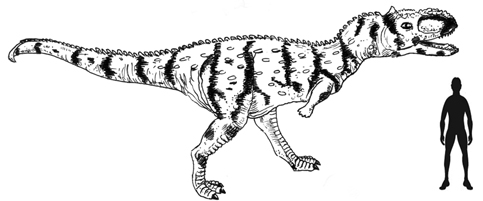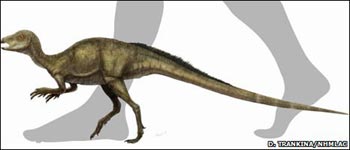Answering Questions Sent in Over Christmas
Over the last few days we have been catching up with our correspondence and one of the tasks is to answer all the questions sent in by young dinosaur fans. We have had a larger number of questions to handle than in previous years, but we are just about on top of the job. Our thanks to Owen, Jacob, Simon, Theodore, Claire and Steven for sending in this selection of questions.
Questions from Young Dinosaur Fans
How many fingers did Tyrannosaurus rex have?
T. rex has two fingers on each hand. These dinosaurs evolved from dinosaurs that had three fingers on their hands. In some Late Cretaceous tyrannosaurid dinosaur fossils a vestigial third finger can be made out.
Was Rajasaurus a powerful dinosaur?
Rajasaurus (the name means “Prince Lizard”) was a member of the abelisaurid group of meat-eating dinosaurs. The fossils of this dinosaur have been found in Upper Cretaceous rocks of India. At around eleven metres in length and weighing an estimated 3-4 tonnes this was a indeed a powerful and fearsome hunter. Living at the same time as Rajasaurus was a second, slightly smaller and more lightly built abelisaurid. This dinosaur has been named Indosuchus. It has been suggested that these two predators did not compete for food, Indosuchus tackling smaller animals and the larger Rajasaurus specialising in attacking the really big herbivores such as titanosaurs.
A Scale Drawing of Rajasaurus

Probably an apex predator in its environment.
Picture credit: Everything Dinosaur
There is now strong evidence that these predatory dinosaurs also lived in Europe during the Late Cretaceous. To read an article about the discovery of an abelisaurid from France: New French abelisaurid Named after Road Builder.
Where have fossils of Liliensternus been found?
Fossils of this Late Triassic carnivorous dinosaur have been found in Germany and France.
What were the top five biggest meat-eating dinosaurs? What were the largest carnivorous dinosaurs called?
This is difficult to say as a number of the very large, carnivorous dinosaurs are known from fragmentary or partial remains. Some of the largest meat-eating dinosaurs known include Giganotosaurus, Allosaurus fragilis, Saurophaganax, Spinosaurus, Acrocanthosaurus, Torvosaurus gurneyi, Tyrannosaurus rex, Carcharodontosaurus saharicus, Tarbosaurus, Sauroniops pachytholus, Tyrannotitan, Mapusaurus, Zhuchengtyrannus magnus.
You can find out more information about these dinosaurs by searching through the articles on this web log or perhaps by looking at dinosaur books.
Was Compsognathus the fastest dinosaur?
Compsognathus was regarded as the smallest dinosaur known for a number of years, but fossil finds in the late 20th Century led to the describing of a number of new species of smaller dinosaurs. Compsognathus was certainly a swift runner and quite agile and in a study by Manchester University scientists, which compared the velocities of a number of dinosaurs, as well as humans and some flightless birds, Compsognathus came out as the faster sprinter.
To read the article and see the performance table: Could T. rex Run Faster than David Beckham?
However, a number ornithomimid dinosaurs (ostrich mimics), with their longer legs and bigger stride length could probably run faster, certainly in a straight line when compared to the diminutive Compsognathus. It has been estimated that a dinosaur like Sinornithomimus could have sprinted at over 40 miles per hour.
How big was the horned dinosaur Albertoceratops?
Size estimates vary, but this horned dinosaur from the Late Cretaceous of North America was probably around five to six metres in length when fully grown.
Was Mapusaurus a strong dinosaur?
Muscle mass of a dinosaur is difficult to calculate, however, the size and position of key muscle groups can be studied by looking at the scars which indicate areas of muscle attachment on fossil bone. Mapusaurus (M. roseae) was certainly a large predator. There is some evidence to suggest that these animals hunted in packs. The short arms were quite strong, but the hind legs were very powerful indeed. It has been estimated that this dinosaur could run at speeds approaching 25 miles per hour, perhaps as fast as 30 miles per hour.
To read an article in which Mapusaurus is compared with Tyrannosaurus rex: Was Mapusaurus as Big as T. rex?
Everything Dinosaur stocks a large range of theropod dinosaur models including T. rex and Mapusaurus. To view our range: Prehistoric Animal and Dinosaur Models.
What was the smallest dinosaur? Was the smallest dinosaur Bambiraptor?
A number of recent fossil discoveries has enabled scientists to reconsider which was the smallest dinosaur. For a long time Mussaurus was thought to be the smallest dinosaur, however, the fossil upon which this claim had been made was actually a baby and as a prosauropod, Mussaurus probably grew to more than three metres in length. Several different types of dinosaur are believed to have been less than a metre long, perhaps weighing less than four kilogrammes.
Bambiraptor was around a metre in length, although the holotype material probably represents a juvenile. The tiny, feathered theropod from Mongolia known as Shuvuuia has been estimated to have been just sixty centimetres long. Both Microraptor and Micropachycephalosaurus were extremely small, with estimates for the size of Microraptor at around seventy centimetres and weighing perhaps no more than two kilogrammes.
In 2011, Everything Dinosaur wrote an article all about the “Ashdown Maniraptoran” this is the smallest dinosaur known from Europe, it was about the size of a magpie.
To read the article: The Smallest European Dinosaur.
The current title holder of the “smallest dinosaur known to science” is Fruitadens (F. haagarorum). It may have reached lengths of around forty centimetres, more than half of its body length was made up of its tail. It weighed as much as two bags of sugar, around 1-2 kilogrammes. The fossils of this tiny dinosaur were found in Colorado. It is a bird-hipped dinosaur, most probably a plant-eater but it may also have eaten insects.
A Scale Drawing of Fruitadens (Fruitadens haagarorum)

An illustration of perhaps the smallest dinosaur known Fruitadens.
Picture credit: D. Trankina/NHMLAC
Which was the more powerful dinosaur Allosaurus or Suchomimus?
These are two very different theropod dinosaurs making comparisons a bit difficult. Allosaurus fragilis for example, lived during the Late Jurassic, whilst Suchomimus fossils have been found associated with Cretaceous strata at least thirty million years older. Suchomimus fossils were found in Niger (Africa), whereas Allosaurus fragilis fossils come from the western United States.
In terms of size, Allosaurus may have been slightly bigger at around twelve metres and Allosaurus probably specialised in hunting and eating other dinosaurs, whilst Suchomimus being a member of the Spinosauridae family was probably primarily a fish-eater. Suchomimus did have stronger arms and shoulders than Allosaurus (most likely).
Where were the fossils of Barosaurus found? Did the dinosaur called Barosaurus exist?
Barosaurus, the name means “heavy lizard” and the name is pronounced Bah-row-sore-us, was a sauropod that lived in the Late Jurassic. It was a member of the diplodocid dinosaur family and its fossils have been found in the western United States (South Dakota, as well as possibly Utah and Wyoming). It may have reached lengths in excess of 27 metres and weighed as much as 20 tonnes. Its fossils are relatively rare and when compared to the better known Diplodocus genus, Barosaurus had a longer neck but a shorter tail.
It has been suggested that Barosaurus was a browser of tall trees and the fossils found are associated with wetter parts of what is now known as the Morrison Formation. A wetter habitat could have allowed the trees to grow taller, ideal for a long-necked Barosaurus to browse upon.
Thank you for all the questions sent in to us, we shall continue to work hard and answer them as best as we can.




